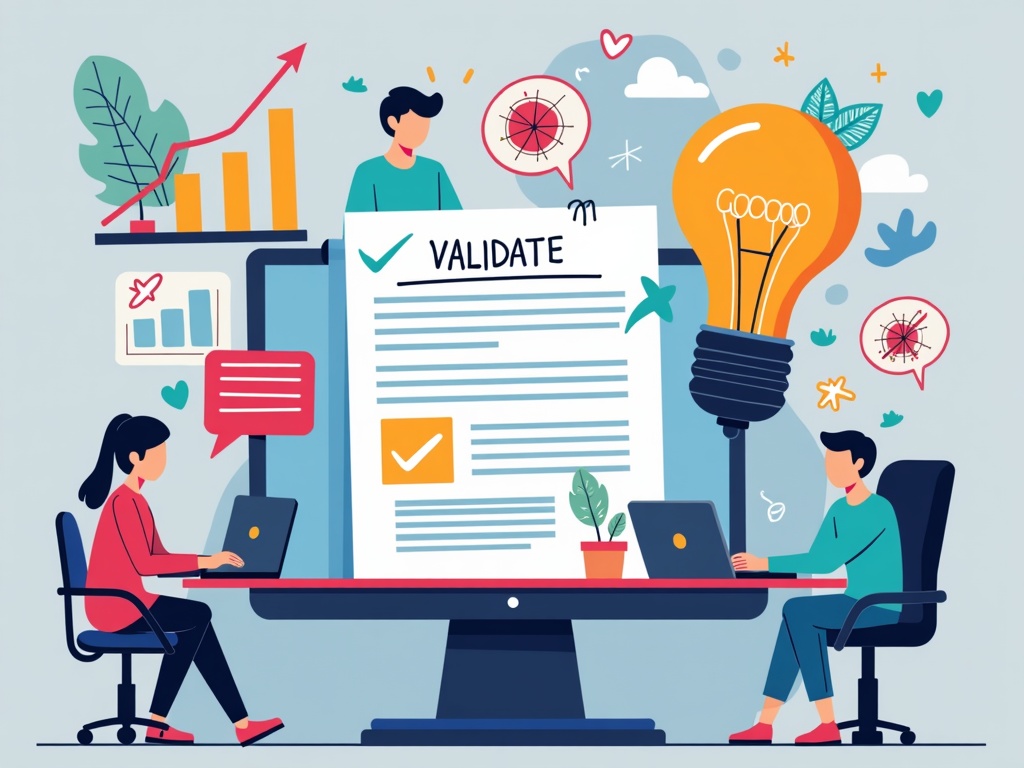Is Your Startup Idea a Winner? How to Validate Before You Build
Imagine pouring your heart, soul, and savings into a startup, only to launch and hear…crickets. That’s the nightmare scenario every entrepreneur fears. The good news? It's largely avoidable. The key is rigorous validation – proving there's a real market need for your brilliant idea *beforeyou invest heavily in building it. This article dives deep into actionable strategies to validate your startup idea and significantly increase your chances of success.
Why Bother Validating Your Startup Idea?
Simply put, validation reduces risk. Startups are inherently risky ventures, and launching without validation is like jumping off a cliff blindfolded. Validation helps you:
**Avoid Building Something Nobody Wants:This is the biggest pitfall. Validation ensures you're solving a real problem for a real audience.
**Save Time and Money:Building a full-fledged product only to discover no one needs it is an expensive mistake. Validation helps you iterate quickly and efficiently on a minimal viable product.
**Attract Investors:Investors want to see evidence that your idea has potential. Validation provides that crucial proof.
**Refine Your Idea:The process of validation often reveals insights that can significantly improve your business model, target audience, and even your core offering.
Phase 1: Define Your Assumptions
Before you start testing, you need to identify the core assumptions that underpin your startup idea. These are the beliefs that *mustbe true for your business to succeed. Common assumptions include:
**Problem Assumption:That the problem you're solving is a real pain point for your target audience.
**Solution Assumption:That your proposed solution effectively addresses the problem.
**Market Assumption:That there's a sufficiently large market willing to pay for your solution.
**Growth Assumption:That you can acquire customers at a reasonable cost.
Write down each assumption clearly and rank them in order of importance and risk. Focus your validation efforts on the riskiest and most critical assumptions first. If one of these assumptions proves false, it could invalidate your entire business model.
Phase 2: Research and Analysis
Before diving into direct customer interaction, leverage existing data to gain a better understanding of the market landscape.
Market Research
Comprehensive market research is indispensable. This involves understanding your target audience, industry trends, competitive landscape, and potential market size. Use online tools, industry reports, and publicly available data to gather information.
**Secondary Research:Explore existing research reports, industry publications, and government statistics to understand market size, trends, and demographics.
**Competitive Analysis:Analyze your competitors' strengths and weaknesses, pricing strategies, and customer reviews. Identify gaps in the market that your startup can fill. Tools like SEMrush and Ahrefs can provide valuable insights into competitor strategies.
**Trend Analysis:Stay abreast of industry trends using Google Trends, social media monitoring tools, and industry news aggregators.
Keyword Research
Understanding the language your target audience uses to search for solutions like yours is critical.
Use tools like Google Keyword Planner, SEMrush, and Ahrefs to identify relevant keywords and search volumes.
Analyze the search results for those keywords to understand the competitive landscape and identify content gaps.
This research will inform your marketing strategy and help you tailor your messaging to resonate with your target audience.
Phase 3: Direct Customer Interaction: The Heart of Validation
This is where the rubber meets the road. Getting direct feedback from potential customers is absolutely crucial.
Problem Interviews
The goal of problem interviews is to understand whether the problem you're solving is actually painful enough for people to seek a solution. Conduct these interviews with potential customers, focusing on understanding their pain points, frustrations, and unmet needs.
**Focus on the Problem, Not the Solution:Avoid pitching your idea. Instead, ask open-ended questions about their experiences and challenges.
**Listen Actively:Pay close attention to their responses, body language, and tone of voice.
**Document Everything:Take detailed notes of each interview, including key insights, quotes, and observations.
**Recruit Participants Strategically:Don't just interview friends and family. Seek out individuals who represent your target audience. Use online forums, social media groups, and professional networks to find participants.
Solution Interviews
Once you've validated the problem, it's time to test your proposed solution. Solution interviews aim to gather feedback on your idea, gauge interest, and identify potential improvements.
**Present Your Solution Concisely:Briefly explain your idea and its key features.
**Focus on Value Proposition:Highlight the benefits of your solution and how it addresses their pain points.
**Gather Honest Feedback:Encourage participants to share their honest opinions, even if they're negative.
**Prototype and Test:If possible, create a simple prototype or mockup of your solution to gather more concrete feedback. Tools like Figma and InVision are great for creating interactive prototypes.
Landing Pages and Coming Soon Pages
Create a simple landing page that describes your product or service and its value proposition. Include a call to action, such as signing up for an email list or requesting a demo. This allows you to gauge interest and collect leads *beforeyou build anything.
**A/B Test Different Headlines and Copy:Experiment with different messaging to see what resonates best with your target audience.
**Track Conversion Rates:Monitor the number of visitors who sign up or request a demo.
**Use Tools Like Unbounce or Leadpages:These platforms make it easy to create and test landing pages.
Crowdfunding Campaigns
Launching a crowdfunding campaign on platforms like Kickstarter or Indiegogo can be a powerful way to validate your idea, raise capital, and build an early community. A successful campaign demonstrates that there's genuine demand for your product.
**Create a Compelling Pitch:Clearly articulate your value proposition and showcase your product's features and benefits.
**Offer Rewards and Incentives:Encourage people to back your project by offering attractive rewards.
**Engage with Your Backers:Respond to comments and questions promptly.
**Set a Realistic Funding Goal:Avoid setting an unrealistically high goal that you're unlikely to reach.
Minimum Viable Product (MVP)
An MVP is a version of your product with just enough features to attract early-adopter customers and validate a product idea early in the development cycle. The goal is to gather feedback and iterate quickly.
**Focus on Core Functionality:Include only the essential features that solve the core problem.
**Gather User Feedback:Track how users interact with your MVP and actively solicit feedback.
**Iterate Based on Feedback:Continuously improve your product based on user feedback.
Phase 4: Analyzing the Results and Iterating
Validation is an ongoing process, not a one-time event. After gathering data and feedback, analyze the results and use them to refine your idea and business model.
Analyze Data and Identify Patterns
Look for patterns in your data. Are there common themes or pain points that emerge from your customer interviews? Are certain features of your MVP more popular than others?
Pivot or Persevere
Based on your findings, you may need to pivot (change direction) or persevere (stay the course). Pivoting doesn't mean you've failed; it means you're adapting to new information.
Refine Your Value Proposition
Clearly articulate the value that your product or service provides to your target audience. This should be based on the insights you've gained through validation.
Key Takeaways
Validating your startup idea is crucial for minimizing risk and maximizing your chances of success. By following these steps, you can gather valuable feedback, refine your idea, and build a product that people actually want. Remember:
**Focus on solving a real problem.**
**Talk to your target audience.**
**Be willing to iterate and pivot.**
Don't be afraid to fail fast and learn from your mistakes.**
Validation isn't just a step in the startup process; it's a mindset. By embracing a validation-driven approach, you can build a more resilient and successful business. So before you pour your heart and soul into building your dream, take the time to validate your idea – it could be the best investment you ever make.


